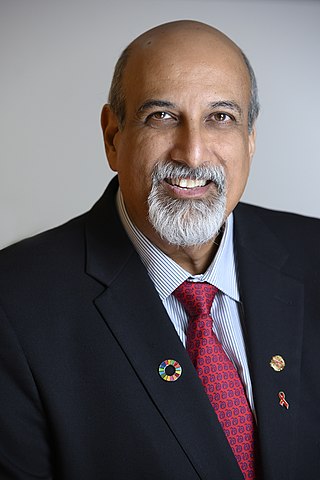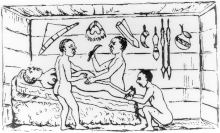
Traditional healers of Southern Africa are practitioners of traditional African medicine in Southern Africa. They fulfill different social and political roles in the community like divination, healing physical, emotional, and spiritual illnesses, directing birth or death rituals, finding lost cattle, protecting warriors, counteracting witchcraft and narrating the history, cosmology, and concepts of their tradition.

HIV/AIDS originated in the early 20th century and has become a major public health concern and cause of death in many countries. AIDS rates varies significantly between countries, with the majority of cases concentrated in Southern Africa. Although the continent is home to about 15.2 percent of the world's population, more than two-thirds of the total population infected worldwide – approximately 35 million people – were Africans, of whom around 1 million have already died. Eastern and Southern Africa alone accounted for an estimate of 60 percent of all people living with HIV and 100 percent of all AIDS deaths in 2011. The countries of Eastern and Southern Africa are most affected, leading to raised death rates and lowered life expectancy among adults between the ages of 20 and 49 by about twenty years. Furthermore, life expectancy in many parts of Africa is declining, largely as a result of the HIV/AIDS epidemic, with life-expectancy in some countries reaching as low as thirty-nine years.

Nevirapine (NVP), sold under the brand name Viramune among others, is a medication used to treat and prevent HIV/AIDS, specifically HIV-1. It is generally recommended for use with other antiretroviral medications. It may be used to prevent mother to child spread during birth but is not recommended following other exposures. It is taken by mouth.
Male circumcision reduces the risk of human immunodeficiency virus (HIV) transmission from HIV positive women to men in high risk populations.

The sociology of health and illness, sociology of health and wellness, or health sociology examines the interaction between society and health. As a field of study it is interested in all aspects of life, including contemporary as well as historical influences, that impact and alter our health and wellbeing.

The global pandemic of HIV/AIDS began in 1981, and is an ongoing worldwide public health issue. According to the World Health Organization (WHO), by 2023, HIV/AIDS had killed approximately 40.4 million people, and approximately 39 million people were infected with HIV globally. Of these, 29.8 million people (75%) are receiving antiretroviral treatment. There were about 630,000 deaths from HIV/AIDS in 2022. The 2015 Global Burden of Disease Study estimated that the global incidence of HIV infection peaked in 1997 at 3.3 million per year. Global incidence fell rapidly from 1997 to 2005, to about 2.6 million per year. Incidence of HIV has continued to fall, decreasing by 23% from 2010 to 2020, with progress dominated by decreases in Eastern Africa and Southern Africa. As of 2020, there are approximately 1.5 million new infections of HIV per year globally.

A traditional birth attendant (TBA), also known as a traditional midwife, community midwife or lay midwife, is a pregnancy and childbirth care provider. Traditional birth attendants provide the majority of primary maternity care in many developing countries, and may function within specific communities in developed countries.

The human immunodeficiency virus (HIV) is a retrovirus that attacks the immune system. It can be managed with treatment. Without treatment it can lead to a spectrum of conditions including acquired immunodeficiency syndrome (AIDS).
Edward C. (Ted) Green is an American medical anthropologist working in public health and development. He was a senior research scientist at the Harvard School of Public Health and served as senior research scientist at the Harvard Center for Population and Development Studies for eight years, the last three years as director of the AIDS Prevention Project. He was later affiliated with the Department of Population and Reproductive Health at Johns Hopkins University (2011–14) and the George Washington University as research professor. He was appointed to serve as a member of the Presidential Advisory Council on HIV/AIDS (2003–2007), and served on the Office of AIDS Research Advisory Council for the National Institutes of Health (2003–2006). Green serves on the board of AIDS.org and the Bonobo Conservation Initiative. and Medical Care Development.
The United States Military HIV Research Program was initiated by the United States Congress in 1986, in reaction to the threat of lost effectiveness of U.S./Allied troops due to HIV infection. The mission of MHRP is to develop an HIV-1 vaccine, provide prevention, care, and treatment, and conduct meaningful HIV/AIDS research for the global community through the President's Emergency Plan for AIDS Relief (PEPFAR). It is centered at the Walter Reed Army Institute of Research (WRAIR), and has established five international research sites in Africa and Asia. MHRP also partners with the Armed Forces Research Institute of Medical Sciences (AFRIMS) in Thailand. MHRP works closely with The Henry M. Jackson Foundation for the Advancement of Military Medicine (HJF), most notably in the development of the RV144 HIV vaccine in Thailand. MHRP is the largest research program supported by the HJF.

Traditional African medicine is a range of traditional medicine disciplines involving indigenous herbalism and African spirituality, typically including diviners, midwives, and herbalists. Practitioners of traditional African medicine claim, largely without evidence, to be able to cure a variety of diverse conditions including cancer, psychiatric disorders, high blood pressure, cholera, most venereal diseases, epilepsy, asthma, eczema, fever, anxiety, depression, benign prostatic hyperplasia, urinary tract infections, gout, and healing of wounds and burns and Ebola.
HIV prevention refers to practices that aim to prevent the spread of the human immunodeficiency virus (HIV). HIV prevention practices may be undertaken by individuals to protect their own health and the health of those in their community, or may be instituted by governments and community-based organizations as public health policies.
This article is about traditional Hausa medicine practised by the Hausa people of West Africa.

The AIDS Support Organization (TASO) is an indigenous HIV and AIDS service initiative, registered in Uganda as a non-governmental organisation. It is a pioneer non-public actor in the HIV and AIDS response in Uganda. TASO is a membership organisation with over 4,000 subscriber members.

Salim S. Abdool Karim, MBChB, MMed, MS(Epi), FFPHM, FFPath (Virol), DipData, PhD, DSc(hc), FRS is a South African public health physician, epidemiologist and virologist who has played a leading role in the AIDS and COVID-19 pandemic. His scientific contributions have impacted the landscape of HIV prevention and treatment, saving thousands of lives.
The Organization of African First Ladies for Development (OAFLAD), originally formed as the Organization of African First Ladies against HIV/AIDS (OAFLA), is a nongovernmental, not-for-profit organization founded in 2002 by 37 African first ladies.
Roy D. Mugerwa was a Ugandan physician, cardiologist and researcher. His contribution to the world of academics include being a Professor Emeritus at Makerere University College of Health Sciences in Kampala, cardiology in Uganda, researching HIV/AIDS and tuberculosis, and his efforts to find an effective HIV vaccine.
Professor Paul Waako, is a Ugandan pharmacologist, academic and academic administrator, who serves as the Vice Chancellor of Busitema University, a public university in the Eastern Region of Uganda, since 1 May 2019.
Eder or Idir, is a social institution in Ethiopia used for mutual aid and grants cooperative insurance within specific community. It is an association that primarily assists people with self-help activities or infrastructure, and victims with bereavement such as funeral and other security issues in the community. Along with Equb, Edir is the traditional form of social institution in Ethiopia, despite varied by duration of time. Eder is distinguished from Equb that it is long-term association, whereas Equb can be temporary and permanent.
Charles Obadiah Nimma Wambebe was a professor of pharmacology from Nigeria and served as the director-general/chief executive officer of the National Institute for Pharmaceutical Research and Development (NIPRD), Abuja. He contributed to the development of Niprisan, a phytomedicine for sickle cell disorder management, which led to The World Academy of Sciences Award in Medical Sciences. He also worked as a consultant in traditional medicine for various international organisations and held professorships at Tshwane University of Technology and Makerere University.










